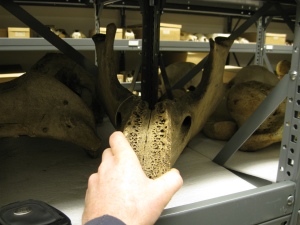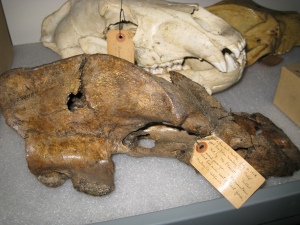 Sure dogs. Clyde rooted around the compost heap to the curious digust of other barbecuers and I obnoxiously riffed, “but, you know the dog story right?”
Sure dogs. Clyde rooted around the compost heap to the curious digust of other barbecuers and I obnoxiously riffed, “but, you know the dog story right?”
So what’s the cat story? Well, long story short:

Chinese Mountain Cat Felis silvestris bieti "looking mean" from Wikimedia licensed, perhaps dubiously, Creative Commons-ShareAlike 3.0
Close wild relatives of the domestic cat include appropriately enough the “wildcat” Felis silvestris complex of numerous nominative subspecies scattered across Eurasia and Africa, including the Chinese desert or mountain cat Felis silvestris bieti sometimes considered a distinct species, Felis bieti. More distant relatives include the sand cat (Felis magarita), jungle cat (Felis chaus), black-footed cat (Felis nigripes), and the riculously adorable Pallas’ cat (Felis manul).
Pumas, ocelots, margays and caracals, previously placed in Felis are these days being placed outside the genus, despite some interfertility among various combinations of these species in capitivity. Bom chika wow wow.
A recent analysis of mitochondrial DNA (Driscoll et al. 2007) suggested that modern domestic cats are derived from the North African/Middle Eastern subspecies Felis silvestris lybica consistent with a “fertile crescent” domestication scenario. The going narrative speculates that grain surplusses associated with grass (co)domestication and the construction of granaries (you know, that whole “birth of civilization” thing) led to standing crops of commensal rodents and hence: cats. All of this seems pretty plausable, especially in light of Towser.

"Grain-counter" Nebamun, wife, daughters and cat, slaughter fowl...give it a while
The cat in the photo at top is a resident of Eatwell Farm in Dixon, CA, and has undoubtedly “moused” a few rodents in her day
The Driscoll et al. (2007) study also revealed (unsurprisingly) substantial introgression among domestic cats and the various wildcats. Bom chika wow wow, indeed. As with dogs, and probably many other human hypercommensals, this genetic “gray-zone” suggests that a) no living population of putative wild ancestor necessarily provides a precise portrait of what the “wild type” was really like and b) “artificial selection” shouldn’t necessarily be regarded as the only engine of diversity of “domestic animals.”
“quotes”
I grew up with cats, many cats, Banner, Ritter, Barney, Shady(Momma), Max, Sadie, Sonic, Vega, Beamer, Metro, Anastasia, Squirrel; I but haven’t actually lived with them in years. At “cat corner” tonight Jessica counted 13, these perfect predators in our midst.
Refs
Driscoll, C. A. et al. 2007. The Near Eastern Origin of Cat Domestication. Science 317: 519-523.

Detail of tomb painting shown above


























